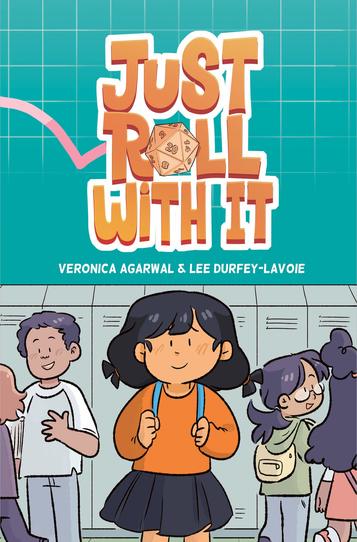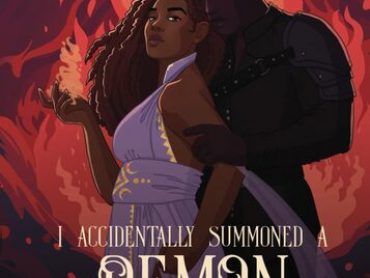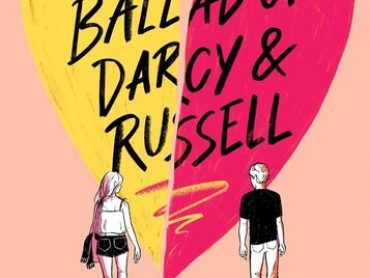Lee Durfey-Lavoie and Veronica Agarwal are the author and illustrator of the graphic novel Just Roll With It. Just Roll with it is a graphic novel that explores the complexity of anxiety, OCD, and learning to trust yourself and the world around you. YEM was able to speak with Lee and Veronica about their favorite things about graphic novels, what they learned about themselves through the process of making the book, and any advice for someone who might want to make a graphic novel as well.
Young Entertainment Mag: What is your favorite thing about graphic novels?
Lee: Where to even begin? As much as I’m a fan of a good prose novel or a delightful movie, I think there is this really specific magic that graphic novels have that nothing else captures. It’s a uniqueness that is captivating across all genres—the very format itself (page layout, borders or no borders, visual stress of words, etc) tells a story.
Veronica: I feel the same! Whenever I get a chance to talk at length about comics, manga or graphic novels, it always highlights the things that you can only do within that medium. As Lee mentioned, the borders, page layout, sound effects etc, are all utilized to create an experience as you read.
YEM: Your book Just Roll With It touches on anxiety and OCD. Why did you decide to make a book that deals with that?
Veronica: Around the time I was coming up with the idea for this book, I was actually diagnosed with OCD myself. It was an interesting journey, because a lot of things I had been doing my whole life (that I thought were normal!!) tied into my obsessive thinking and compulsive behaviors. I wanted to use this book to highlight the aspects of OCD that aren’t talked about as often. Growing up, I had heard the stereotypes about OCD: that it was all about counting objects, cleaning things, or turning lights on and off multiple times. But it turns out that the disorder is much more varied than that, and I wanted to bring that to the forefront, especially in a graphic novel for children.
YEM: Are any of your characters inspired by people in your real life?
Lee: Yes and no. Maggie is heavily taken from the experiences of Veronica and myself but is also her own person. Some character designs, but not personalities, are directly lifted from people in our life. Mr. Popkins, the math teacher, looks exactly like my maternal grandfather while acting absolutely nothing like him. Plenty of our friends make cameos as background characters and in crowd shots as well!
YEM: What do you think the significance is of making a graphic novel dealing with anxiety and OCD geared toward young adults?
Veronica: I grew up in a really good environment, as my family was always interested in mental healing and how it can help your physical health. This gave me a really good platform to stand on as I grew up and learned more about myself and the world around me. I wanted to create this book as a way for kids who may not have that platform to start finding the vocabulary needed to talk about their problems. Mental health can be scary, confusing, and different for everyone. The more we talk about it, the more chances we have for people to realize that mental wellness is something they want to look into further… for themselves or someone they love.
YEM: Did you do any research into anxiety and OCD to learn more about it? What did you learn?
Lee: I did, yes. The largest takeaway that I learned from research—from online forums, to articles, and even discussing the matter with our respective therapists—was that OCD can be incredibly unique. It’s not JUST the hand-washing and strict ordering that TV shows sometimes make it out to be. The pattern is rumination, compulsion to alleviate rumination, rumination gets worse, compulsion gets worse, etc. and it can be about anything. There are literally thousands of examples and we couldn’t find them all into the book—so we had to focus on what we could fit that made sense for Maggie, while also telling a story that was open for all readers.
YEM: Did you learn anything about yourself during the process of making Just Roll With It?
Veronica: I think we both did! It was interesting to see my anxiety and OCD from Lee’s perspective, since he wrote a few of Maggie’s worries based around my own. It was really touching to see Maggie’s worries about her CAT book reflected back at me … and it gave me a chance to treat those worries with more kindness than I might give myself, haha.
Lee: I learned an almost uncomfortable amount of myself creating this book. I thought the years of therapy was a lot but this was an extra layer. I really learned how to write for business and not just pleasure—how to work it into my routine, how to be strict with myself and when to be gentle. I learned to view my own insecurities and anxieties in a different light and understood how to treat them better.
YEM: Do you have any advice for those who want to make graphic novels as well?
Veronica: Of course!! Goodness, I could talk about this for ages to be honest. The big three I would say are
1. Done is better than perfect
2. Work smarter, not harder
and
3. Draw what you love (not just what you think other people will love)!!!
Lee: Oh yeah and it’s probably the simplest, most repeated one out there: you gotta read. Read books you like, then read them again to examine WHY they work. Read books in your target demographic; we both love middle grade/YA graphic novels (there are so many that are so brilliant and expressive of the human condition) and we are reading as often as we can. So read and study what you’re reading and then go for it. You can talk about story structure and the formulas but the best practice is to create and find the process that works for you. Draw it/write it, whichever you like best, or do both!
YEM: What do you hope readers can take away with them after reading Just Roll With It?
Lee: My biggest hope for readers after picking up JUST ROLL WITH IT is that they’re understood, and they don’t feel alone anymore. To give them a voice for their worries and feelings and to let them know they’re not broken, or damaged. Nobody isolates you or treats you like a freak anymore for wearing glasses (or at least they didn’t when I was in middle school)—nobody shames you for taking the necessary steps to alleviate impaired eyesight. All disabilities, and especially mental health, need to be respected and appreciated and understood in the same way and I hope after reading JUST ROLL WITH IT that readers understand that.
YEM: What are some of your all time favorite books?
Veronica: Ahh! Such a hard question! I really adore the Berrybrook Middle School series by Svetlana Chmakova. I grew up reading her books, so all of them are close to my heart. Yotsuba&! And Azumanga Daioh by Kiyohiko Azuma are both series I’ve adored since I was a kid. Recently I picked up the second volume of I Think Our Son Is Gay by Okura, and I really love how sweet and touching the story is.
Lee: A few that have made the top of my list are definitely: Not Drunk Enough volumes 1 and 2 by Tess Stone, I adore what they do with their layouts. Seconds by Bryan Lee O’Malley was really kind of seminal for me, as well as Lucky Penny by Ananth Hirsh.
YEM: What was the collaboration process of the graphic novel like?
Veronica: The way I describe it is that I presented the skeleton, Lee gave it the muscle and skin, and then I gave it hair and clothing!! The entire time this was a group project between both of us, and we checked in a lot during each stage. After Lee finished the script, we edited it together. I also consulted him a lot during the penciling stage about shifting shots around or adding a scene here or there.
Lee: As Veronica said it was really a constant dialogue between us: does this dialogue need to get changed, or gutted entirely? Does it need to be moved here? Should we do x, y, or z as a shot instead? Which angle looks better? I think it made us both better and if there was any doubt before that she has the harder job it was definitely squashed by the time we were done. The illustrations, from pose to color, just make everything so moving and wonderful.
YEM: Do you have any plans to make any more?
Veronica: Yes!! I’m working on the next book in the Just Roll With it series, and we have a few more ideas rattling around in our head that we want to make!!
YEM: How long did it take to make Just Roll With It?
Lee: From the very first scribble down in the notes app to now it’s been five years, though direct work on the graphic novel after we finished contract negotiations was probably two years, which included time for our amazing editor Whitney Leopard and the rest of the team at Random House Graphic to get us edits and then also includes the whole ‘actually printing the book’ thing as well, haha.




